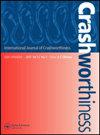Vawter-Fung肺组织本构模型材料参数识别及人体冲击载荷模型评估
IF 1.8
4区 工程技术
Q3 ENGINEERING, MANUFACTURING
引用次数: 0
摘要
摘要:本文对最初用于模拟呼吸的Vawter-Fung (VF)肺组织本构模型在冲击人体模型(HBMs)中的适用性进行了评估。对肺组织力学特性的回顾表明,VF模型的现有参数集包含了相对于实验数据的大范围刚度。确定了肺组织单轴和双轴张力的一致实验数据集,并对VF模型进行了拟合。采用当代HBM进行胸椎钟摆冲击,评估现有文献参数集和新参数。与实验数据和先前报道的参数相比,本研究中提出的VF模型参数产生了单轴和双轴拉伸响应,并改善了超弹性响应。VF表面张力成分对肺部冲击反应没有实质性贡献。所提出的VF模型参数在冲击模拟和HBMs应用中具有数值稳定性。关键词:肺组织力学性能材料参数本构建模人体模型冲击反应作者贡献声明Singh创建并执行了模型模拟。所有作者都为撰写手稿做出了贡献。披露声明作者未报告潜在的利益冲突。本文章由计算机程序翻译,如有差异,请以英文原文为准。
Identification of material parameters for the Vawter-Fung lung tissue constitutive model and assessment in human body model for impact loading
AbstractThe widely used Vawter-Fung (VF) lung tissue constitutive model, originally developed to model respiration, was assessed for applicability to impact human body models (HBMs). A review of the mechanical properties of lung tissue demonstrated existing parameter sets for the VF model encompassed a wide range of stiffness relative to experimental data. Consistent experimental datasets of lung tissue for uniaxial and biaxial tension were identified, and new parameters were fit to the VF model. A thoracic pendulum impact using a contemporary HBM was used to assess existing literature parameter sets, and the new parameters. The VF model parameters presented in this study produced uniaxial and biaxial tension response with improved hyperelastic response compared to experimental data and previously reported parameters. The VF surface tension component did not contribute substantially to the lung response in impact. The proposed VF model parameters were numerically stable for impact simulations and use in HBMs.Keywords: Lung tissuemechanical propertiesmaterial parametersconstitutive modellinghuman body modelsimpact response Author contributions statementD. Singh created and performed the model simulations. All authors contributed to writing the manuscript.Disclosure statementNo potential conflict of interest was reported by the authors.
求助全文
通过发布文献求助,成功后即可免费获取论文全文。
去求助
来源期刊

International Journal of Crashworthiness
工程技术-工程:机械
CiteScore
3.70
自引率
10.50%
发文量
72
审稿时长
2.3 months
期刊介绍:
International Journal of Crashworthiness is the only journal covering all matters relating to the crashworthiness of road vehicles (including cars, trucks, buses and motorcycles), rail vehicles, air and spacecraft, ships and submarines, and on- and off-shore installations.
The Journal provides a unique forum for the publication of original research and applied studies relevant to an audience of academics, designers and practicing engineers. International Journal of Crashworthiness publishes both original research papers (full papers and short communications) and state-of-the-art reviews.
International Journal of Crashworthiness welcomes papers that address the quality of response of materials, body structures and energy-absorbing systems that are subjected to sudden dynamic loading, papers focused on new crashworthy structures, new concepts in restraint systems and realistic accident reconstruction.
 求助内容:
求助内容: 应助结果提醒方式:
应助结果提醒方式:


